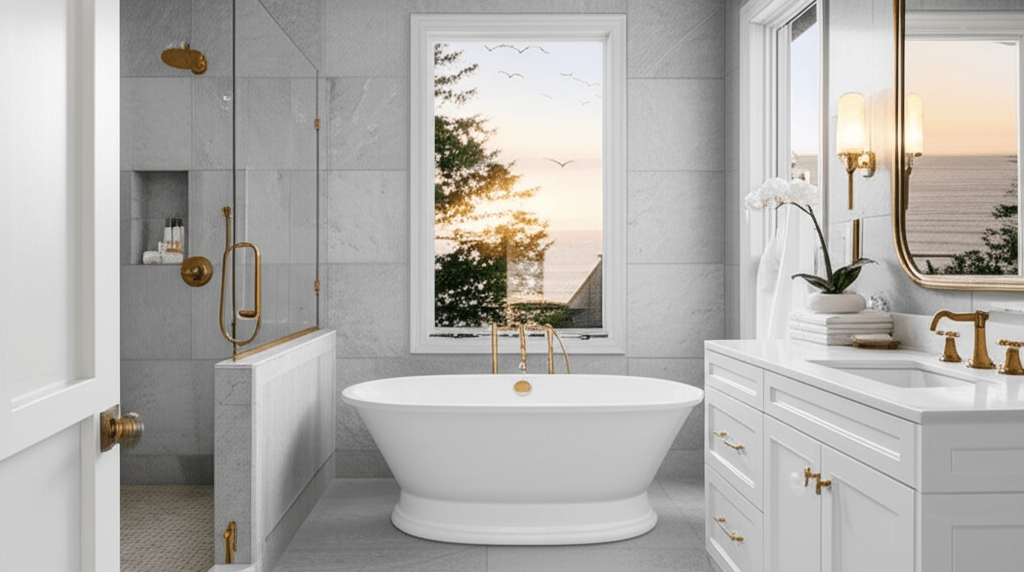The Ultimate Bathroom Remodeling Guide
A well-designed bathroom is a functional necessity and a private sanctuary.
Whether you're planning a simple powder room update or a luxurious master suite overhaul, this guide will provide the information you need to create a space that is both beautiful and built to last.
Section 1: Planning Your Perfect Bathroom
Success starts with a clear plan that addresses both your practical needs and aesthetic desires.
Full Remodel vs. Wet-Area Remodel
-
Full Remodel: Involves changing everything, including flooring, vanity, toilet, and shower/tub.
-
Wet-Area Remodel: Focuses only on the shower and/or tub area, a quicker and more affordable update.
Defining Your Needs: Family Bath or Master Suite?
The bathroom's primary users will dictate its design.
A shared family bathroom needs durable materials and ample storage, while a master suite can prioritize luxury features like a soaking tub or steam shower.
Gathering Inspiration and Choosing a Style
Collect images of bathrooms you love.
Consider styles like spa-inspired modern, classic traditional, or rustic farmhouse.
This will help you select a cohesive palette of materials and fixtures.
Section 2: Bathroom Layouts
A smart layout is essential, especially in smaller bathrooms, to maximize every square inch.
Maximizing Small Spaces
For small bathrooms, consider a wall-mounted vanity, a corner shower, a pocket door instead of a swinging door, and a large mirror to create an illusion of space.
Common Layouts and Clearances
Ensure you follow building codes for clearances around toilets and sinks.
A functional layout provides comfortable movement and easy access to all fixtures.
Tub-to-Shower Conversions
Removing a rarely used bathtub to install a spacious, accessible walk-in shower is one of the most popular bathroom remodeling projects today.
It can make the room feel larger and more modern.
Section 3: Materials & Surfaces
Bathrooms demand materials that can stand up to constant moisture and use.
Tile for Floors and Walls
-
Porcelain & Ceramic: The most popular choices due to their durability, water resistance, and vast range of styles.
-
Natural Stone: Offers a luxurious look but often requires more maintenance and sealing.
-
Large-Format Tiles: Can make a small bathroom feel bigger by minimizing grout lines.
Vanities and Countertops
Choose a vanity that offers adequate storage.
Quartz is an excellent countertop choice for bathrooms as it is non-porous and resists stains from makeup and toiletries.
Waterproofing and Ventilation: The Essentials
Proper waterproofing behind tile in wet areas is critical to prevent leaks and mold.
A powerful, quiet ventilation fan is equally important to remove moisture from the air.
Section 4: Fixtures & Features
The fixtures you choose are the functional jewelry of your bathroom.
Showers, Tubs, and Toilets
-
Showers: Consider features like rain showerheads, handheld sprayers, and built-in niches for storage.
-
Tubs: Freestanding tubs are a popular luxury statement, while alcove tubs are practical for shower/tub combos.
-
Toilets: Look for water-saving models. Comfort-height toilets are more accessible and ergonomic.
Sinks and Faucets
Vessel sinks can add a dramatic touch, while undermount sinks offer a clean, easy-to-maintain surface.
Wall-mounted faucets can free up counter space.
Lighting and Storage Solutions
A good lighting plan includes an overhead light, and task lighting at the vanity.
Smart storage solutions like medicine cabinets, vanities with drawers, and open shelving are key to a clutter-free space.
Section 5: Budgeting and Project Management
Understand the costs and process to ensure a smooth renovation.
Bathroom Remodel Cost Breakdown
A mid-range bathroom remodel typically costs between $15,000 and $35,000.
Key costs include labor, tile work, plumbing fixtures, and the vanity.
DIY vs. Hiring a Professional
While you can handle cosmetic updates like painting, it's best to hire licensed professionals for tile work, plumbing, and electrical to ensure it's done correctly and to code.
What to Expect During Construction
Expect a period of dust and noise.
Your contractor should seal off the work area to minimize disruption to the rest of your home.
Clear communication is essential throughout the process.
